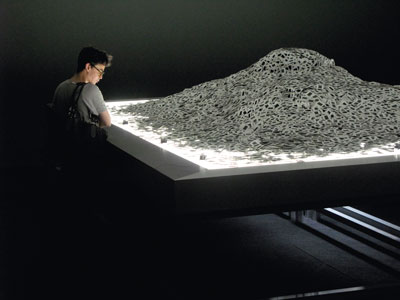Alfredo Jaar
Verschiedene Orte, Berlin & Kunstverein Arnsberg
Verschiedene Orte, Berlin & Kunstverein Arnsberg

Alfredo Jaar aims to prod art viewers into action. His work has a classic status among documentary approaches opposing the construction of reality by mass media. This reputation was further solidified by a retrospective this summer, which was organized by the curatorial collective Realismusstudio at Berlin’s Neue Gesellschaft für Bildende Kunst (NGBK) along with a second show at the Berlinische Galerie and two interventions at the Alte Nationalgalerie. The exhibition’s title The Way It Is. An Aesthetics of Resistance – perhaps partly inspired by Peter Weiss’s epic novel – presented Jaar as a humanist enlightener of the old school.
The NGBK show focused on early work and thus on the artist’s response to the military junta that took over in his native Chile in 1973. Jaar appears in his own works, dissolving his photograph into barcodes (Self Portrait, 1977) or blowing into a clarinet to the point of exhaustion as a bitter lament on the powerlessness of young Chileans (Opus 1981, Andante Desperato, Desperate Andante, 1981). After using strong black and white contrasts that can be read as metaphors for the light of reason, Jaar developed the strategies that became central to his later work. One is commemorating key events, as in September 11, 1973 (1974), a black calendar that repeats this date of the Pinochet putsch for every day thereafter in 1973. Another strategy: archive installations levelling charges at key political figures, like Searching for K (1984). This series of photographs shows Henry Kissinger with red rings around his head and thus highlights the role of the American national security advisor in imperialist interventions by the United States, especially in South America.
Whereas the discreet sobriety of the NGBK show suggested an exemplary historical overview, much of the material presented at Berlinische Galerie consisted of large-scale theatrical installations. The focus here was on works addressing the (mis)representation of the African continent in ‘Western’ media. The prints in the series Untitled (Newsweek) (1994) combined brief text descriptions of events during the Rwanda genocide of 1994 with covers of Newsweek magazine which, the work suggests, ignored the killing until it was almost over. Frustrated by such ignorance, Jaar visited Rwanda several times himself. Some of the photographs he took on these journeys were hidden in ash-grey linen boxes which were outfitted with short descriptive texts and arranged as dimly lit minimalist sculptures (Real Pictures, 1995). In this work, Jaar poses a question about the representability of genocide, as in The Eyes of Gutete Emerita (1996): a horizontal lightbox with a million ash-grey slide frames resembling a mound of corpses, each one showing the eyes of a woman who has witnessed a massacre. He also offers an answer: to withdraw images. The artist puts this withdrawal on display – a kind of ‘not-showing’ on show – in a gesture filled with pathos; but one which still fails in avoiding an aesthetic appropriation of the atrocities.

These installations slow the stream of images and arrange them in three dimensions as a way of fostering contemplation. With blacked-out lightboxes, Lament of the Images (2002) demonstrates how the market and politics restrict access to reality; three examples were presented in just as many texts in lightboxes: how Nelson Mandela was partially blinded by being forced to work in a lime quarry, how large parts of the Corbis agency’s picture archive have been locked away and how the US military purchased all satellite images of Afghanistan before the invasion. In the space, a dark corridor led to a blindingly bright neon square. The links between these stories were loose, and the emotional impact Jaar might have been aiming for in the dazzling finale was diffuse. Staged as a dead end, the work raised no questions that might lead any further beyond it.
Throughout the show, Jaar gave his topics drastic treatments, embedding them in opulent, pathos-laden installations. The texts accompanying his ‘non-showings’ couched their lessons in mantra-like repetitions – just as Jaar focused on the same events and figures. In his work, as in the 18th-century sentimental theatrical genre of comédie larmoyante, politics is reduced to individual actions and tears. The film We Wish To Inform You That We Didn’t Know (2010) identifies Bill Clinton, then-President of the United States, as the main culprit in the Rwandan genocide. Instead of reflecting on the economic and political conditions that made a UN intervention seem unprofitable, the film ends with a sentimental montage of graves, dead people’s clothes and music by the DR Congo soukous star Papa Wemba.
Yet another exhibition took place this fall at Kunstverein Arnsberg: Fünf Wolken (Five Clouds), presenting Jaar’s recent video and film works on Africa, which also aimed for empathy. Monitors show mourners – filmed from behind – in Rwanda (Embrace, 1995), a work also included in the show at the Berlinische Galerie. These scenes prescribe an emotional response to the tragedy but block any insight into its causes. And however empathetic and many-voiced the 30-minute film portrait of Angola entitled Muxima (2005) may be, its suggestive, manipulative editing speaks of the shaping power of an artist whose camera lingers on unknown faces but who remains behind the image and thus out of the viewer‘s sight. He presides over the arrangement of protagonists and objects without addressing his own privileged role in the production of images. The results frequently take the form of memorials and oratories, consternation and emotion. But as Bertolt Brecht argued, eliciting an emotional response cements the prevailing conditions rather than generating insight into the possibility of altering them. In this way, Jaar actually erects walls that divide the publics between which he claims to mediate. The end result is more aesthetics than resistance.
Translated by Nicholas Grindell
















